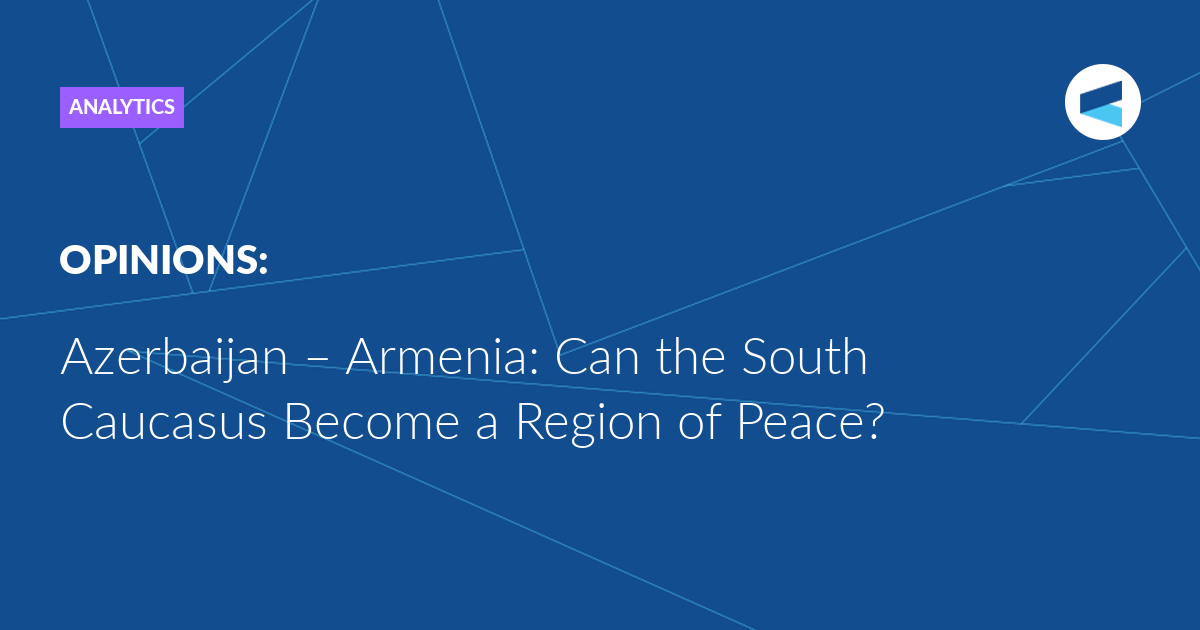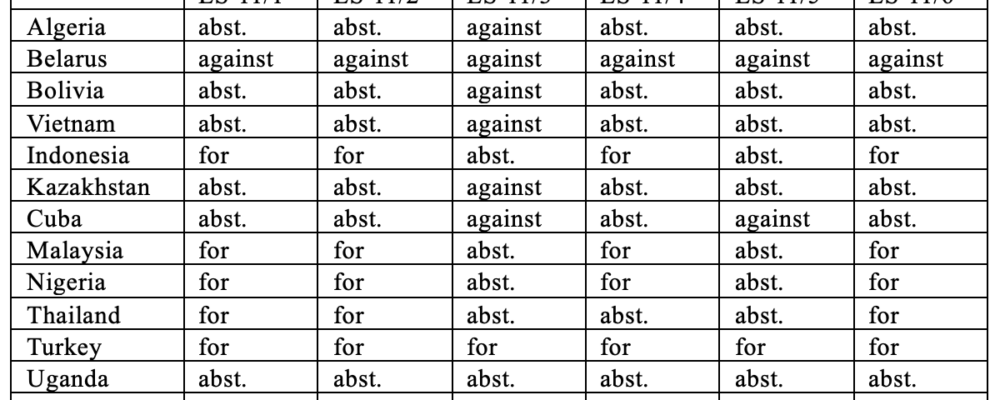The multidirectional geopolitical interests of regional and external players, which directly influence the difficult socio-political transformations in the region, keep us from being optimistic about the rapid transformation of the South Caucasus into a zone of peace – even if some document on the normalisation of relations between Baku and Yerevan has formally acquired legal status, Andrei Areshev
writes.
In September 2023, Azerbaijan restored military and administrative control over the entire territory of the unrecognized Nagorno-Karabakh Republic, which, in accordance with the decree of its last president Samvel Shahramanyan, ceased to exist on January 1, 2024. The main military successes were achieved by the Azerbaijani army during the “44-day war” in autumn 2020. The purely temporary nature of the new line of demarcation between the parties was obvious from the very beginning, as well as the extremely limited functional capabilities of the Russian peacekeeping contingent deployed in Nagorno-Karabakh in accordance with the statement of the presidents of Russia, Azerbaijan and the prime minister of Armenia, which none of the parties have withdrawn their signature from, despite the public rhetoric regarding the latter. Signed after the Azerbaijani army occupied the entire southern border along the Aras River, after the fall of Hadrut and Shushi (which opened a direct road to Stepanakert for the Azerbaijani Army), it made it possible to stop active hostilities, which by that time had taken on an extremely unfavourable character for the Armenian side.
The exodus of the Armenian population of Nagorno-Karabakh in September 2023 was the final chapter in the 35-year history of the Karabakh movement, which most citizens of the then Soviet Union learned about in February 1988 – after an extraordinary session of people’s deputies of the Nagorno-Karabakh Autonomous Region addressed the Supreme Soviets in Moscow, Yerevan and Baku with a request to consider the issue of transferring the region from the Azerbaijan SSR to the Armenian SSR. Despite the sensitive defeats during the “first” Karabakh war of 1991-1994, Azerbaijan never hid its ultimate goal of gaining complete control over the lost territories through political-diplomatic or military means, strengthening the army and other security forces, as well as forming a favourable political and diplomatic background for itself, including through the signing of the “Contract of the Century” in 1994 with the subsequent formation of transport and logistics infrastructure bypassing Armenian territory. It must be admitted that Azerbaijan has succeeded a lot in this, ultimately receiving support (no matter how controversial this thesis may seem to some readers), including from Yerevan, from the government of Nikol Pashinyan, which is consistently and purposefully working for “de-Karabakhisation” of both foreign policy and domestic policy agendas.
This hardly came as a surprise to observers who had a real understanding of the activities of the former editor-in-chief of the newspaper Haykakan Zhamanak, who was a street opposition activist and later a member of parliament before becoming known far beyond the borders of the country, who became the head of the government following the turbulent events spring of 2018, which would be more correctly described as a “velvet transfer of power” than a “velvet revolution”.
After the end of hostilities, and especially after the start of the special military operation in Ukraine, the Americans and Europeans began to actively introduce themselves into the negotiation process, based on considerations of intensified geopolitical confrontation, torpedoing Moscow’s mediation efforts. “In the documents that were signed in November 2020 and in subsequent documents, the territory of Karabakh was described as the area of responsibility of the Russian peacekeeping contingent. There was an understanding between the leaders of the three countries that negotiations on the topic of status still had to be continued in order for a final agreement to be reached on this issue. And imagine our surprise when in the fall of 2022, somewhere in Prague, Macron held a conference of the European Political Community. Neither we nor the Ukrainians were invited, but there were Armenians and Azerbaijanis, and Macron together with European Council President Charles Michel invited them to meet. At the meeting they approved a document in which it was said that Azerbaijan and Armenia recognize each other’s territorial integrity in full accordance with the Alma-Ata Declaration of 1991, which stated: all new independent states have borders that coincide with the administrative borders of the union republics of the USSR. That is, Karabakh is within the borders of the Nagorno-Karabakh Autonomous Region of the Azerbaijan Soviet Socialist Republic. We did not know that such an announcement was being prepared, and when it was made, we concluded… that the issue of the status of Karabakh was closed, closed personally by the Prime Minister of Armenia. And that’s where Macron was… what our Western colleagues want is for a peace treaty to be signed only on their territory – that’s a fact…” said Russian Foreign Minister Sergei Lavrov at a press conference dedicated to the main diplomatic results of 2023.
In this context, it is not at all surprising that the initial optimism regarding the imminent prospects of reaching at least a framework agreement or another mutually agreed upon one, be it in Moscow, Tbilisi, Brussels or Washington, gave way to more sceptical assessments. This does not negate well-known steps that the two neighbouring countries made towards each other, such as the November joint statement by the Administration of the President of Azerbaijan and the Office of the Prime Minister of Armenia, which allowed for the exchange of prisoners of war and the removal of Yerevan’s objections to holding the international climate summit COP-29 in Baku. However, optimistic expectations again turned out to be premature, because the complex of Armenian-Azerbaijani contradictions in the Caucasus is by no means limited to the closed long-term perspective on the “Karabakh issue” (at least, this is how it seems to most observers).
In a recent interview, speaking in a harsh tone, Azerbaijani President Ilham Aliyev again listed the issues that Baku intends to resolve in accordance with the right of conquest. This and Armenia’s completely predictable categorical refusal to retreat from positions on the conditional border, occupied in May 2021 and September 2022, “because the border must be defined.” According to the Azerbaijani leader, any claims Yerevan makes are baseless, since there are no settlements on the de facto existing demarcation line between the parties. The conclusion of a peace agreement with Armenia should not depend on the issue of border delimitation, Aliyev believes, including because Baku has not yet completed the delimitation of borders with other neighbours, including friendly Georgia, where, let us recall, there are still reasons for disagreement with respect to the ancient monastery complex of David Gareji.
“Armenia… keeps our villages under occupation, and this is unacceptable. I believe that at the end of this month there will be a meeting of the
commission, which will clarify this issue… The villages must be returned to us. An agreement can also be reached as a result of the work of the commission associated with the enclaves. That is, I think this is a completely logical approach,” Aliyev noted. Declaring some time ago his country’s recognition of Azerbaijan within the borders of the former Soviet republic, with an area of 86.6 thousand square kilometres (which in itself is quite strange – if only because the number of square kilometers can also change due to natural reasons – for example, as the Caspian Sea shallows), Nikol Pashinyan, obviously, also had in mind these small “islands” that make it possible to control roads connecting the Ararat Valley with Georgia, as well as with Syunik and Iran.
If previously military control over Karabakh gave Yerevan some freedom of action in controversial political and legal issues, today the government of Nikol Pashinyan is trying to “catch on” to the administrative boundaries of the Soviet period, proposing to build on the maps of the General Staff of the Soviet Armed Forces of the 1970s. But in Baku, it turns out that they are hardly inclined to agree with this, questioning what they call the transfer of “Azerbaijani lands”, including Yerevan and Syunik, to Armenia in the 20th
century. Another conflict node is connected with the southern region, caused by the desire of interested parties to acquire an extraterritorial “Zangezur corridor”, connecting the main territory of Azerbaijan, the Nakhichevan Autonomous Republic and Turkey along the shortest route: “First of all, they must provide us with unhindered passage in the area between Zangelan and Ordubad. This is their obligation… cargo, citizens and vehicles moving from Azerbaijan to Azerbaijan must pass freely, without being subjected to any inspections and without being involved in customs administration… People and cargo [moving] from Azerbaijan to Azerbaijan must pass without any check. Otherwise, Armenia will forever remain a dead end. If the route I mentioned is not opened, then we do not intend to open the border with Armenia in any other place. That is, therefore, they will get more harm from it than good.”
It is known that various options for transport links through Meghri were repeatedly discussed during the negotiation process between Baku and Yerevan under the auspices of the OSCE Minsk Group. The options discussed then were much more acceptable to the Armenian side, but the loss of Karabakh, coupled with the degradation of key national security systems, inevitably jeopardized the security of Syunik. As Russian Deputy Prime Minister Alexey Overchuk noted, due to Yerevan’s lack of a clear position regarding the work of regional communications, the Zangezur section of the North-South International Transport Corridor is not currently being considered. The hypothetical opening of the railway (via Meghri), as well as the road (through Sisian, as it was in Soviet times) messages would mean Azerbaijan’s predominant control over the south of Armenia, which in the not-too-distant future will lead to a change in the ethno-confessional composition of the region’s population.
It is impossible not to pay attention to Ilham Aliyev’s use of Turkic geographical terms, including on the territory of Armenia. He also mentions the maps of the “Azerbaijan Democratic Republic” of 1918-20, reflecting the broadest possible territorial claims of the Caspian republic in the Caucasus. The current Basic Law of Azerbaijan directly refers to the Constitutional Act “On State Independence of the Azerbaijan Republic” adopted on October 18, 1991, which states that “On April 27-28, 1920, the RSFSR… occupied the territory of the sovereign Azerbaijan Republic, forcibly overthrew the legally elected authorities and put an end to independence, achieved at the cost of enormous sacrifices of the Azerbaijani people,” after which “Azerbaijan, just like in 1806-1828, was again annexed by Russia.” Accordingly, the current Azerbaijan Republic is the legal successor to the Azerbaijan SSR, and the “Musavatist” republic of 1918-20, which was in a state of acute conflict with neighbouring Armenia (with which there were simply no borders), as well as with the Armenians of Nagorno-Karabakh.
The use of historical narratives, often interpreted very loosely and designed to legalise one or another political and legal structure, this time is aimed at consolidating the status quo that emerged as a result of the military operations of 2020-2023. As mentioned above, in the last quarter of a century, Baku has worked effectively to create favourable military and political-diplomatic realities, which have made it possible not only to radically change the status quo, but also to seriously think about ways of further expansion. There is no doubt that the next innovations were not long in coming.
According to Armenian Foreign Minister Ararat Mirzoyan, the proposed peace agreement that Yerevan and Baku have so far exchanged does not include constitutional changes, but Baku sees problems in the Armenian Declaration of Independence: “They voiced it, considered it a problem and presented legal issues. Accordingly, we found their wording problematic.” The preamble of the current Constitution of Armenia mentions the Declaration of Independence adopted in August 1990, which, in turn, mentions the joint Resolution of the Supreme Council of the Armenian SSR and the National Council of Nagorno-Karabakh dated December 1, 1989 “On the reunification of the Armenian SSR and Nagorno-Karabakh”. In addition, in accordance with paragraph 11 of the document, “The Republic of Armenia stands for international recognition of the Armenian genocide of 1915 years in Ottoman Turkey and Western Armenia.” Hardly by coincidence, on January 19, Pashinyan once again stated the need to adopt a new Constitution in Armenia, which can be interpreted in the context of the final “de-Karabakhization” of the internal and external agenda, and at the same time – an ode to the rejection of everything that could cause irritation in neighbouring Turkey.
The deep national humiliation, apathy and frustration experienced in Armenian society, the whipped-up atmosphere of hatred and “witch hunts,” and the growth of radical sentiments are some of the factors driving the decline in the level of Armenian-Russian political and military interaction. The possible withdrawal of Armenia from the CSTO structures, as well as the withdrawal of the 102nd military base and border guards could give rise on the territory of a small country to the reproduction of elements of the “Syrian scenario”, in which certain parts of the national territory are in fact controlled by neighbours, other international players and even their individual structures (a “grey zone”).
The forecasts of the American analytical centre Stratfor for 2024 include a likely resumption of hostilities between Armenia and Azerbaijan: “… the risk of outbreaks or the resumption of a full-scale war remains high, as Azerbaijan seeks to maintain leverage over Armenia.” Counting on strengthening ties with the West, Yerevan will strive for peace agreements with Baku, but disagreements over the order and functioning of regional transit corridors will continue to hinder negotiations. In light of Aliyev’s victory in the February 7 elections, Baku will continue to build up its military capabilities in the border areas, preparing for an invasion and seeking to gain additional leverage in the negotiation process. In the absence of what is considered progress in Baku in the coming months, there is a high risk of escalation on the southern borders of Armenia in the summer.
Yerevan has not abandoned the “peace agenda”, even if Baku deviates from it, Nikol Pashinyan assures, focusing not so much on relations with Russia, but with Turkey and Azerbaijan: “This is where all the questions are and here the answers to all the questions.” In the context of the progressive weakness of key state institutions (whether it be national-state symbols, the church, or the army, which are often subject to direct or veiled attacks from the current government and forces affiliated with it), attempts to radically “reformat” Armenian statehood on fundamentally different grounds are fraught with instability and the growth of civil confrontation. At the same time, socio-political stability in Azerbaijan, camouflaged by a nationalist discourse with elements of expansionism, may be called into question as the world order continues to “crumble”.
Concurrently, global and regional turbulence persists, as well as attempts by interested forces to maintain elusive global dominance. Ostentatious skirmishes between Baku and the structures of the collective West (USA and Europe) do not at all negate the close involvement of transnational structures in the political and economic fabric of the Caspian country,
which may have ambiguous consequences for “meridional” communication projects, such as the North-South International Transport Corridor. Military escalation in the Middle East, one of the key elements of which is the confrontation between Israel and Iran, is increasingly drawing neighbouring regions into its orbit, including the former Soviet Transcaucasus. Another alarming point is the active efforts of the collective West to oust Russia from South Caucasus, accompanied, in particular, by the growth of ethnic radicalism and the infiltration of political and ideological constructs alien to the local peoples.
Russian diplomacy invariably advocates the primacy of regional mechanisms for resolving regional problems and contradictions. In relation to the Caucasus region, we are talking, in particular, about the “three plus three” consultation format, which includes Azerbaijan, Armenia and Georgia, as well as the Russian Federation, the Republic of Turkey and the Islamic Republic of Iran. Fundamental changes in the security structure of the region do not negate the importance of mutually beneficial trade and economic ties and cross-border communication projects, such as the North-South International Transport Corridor. At the same time, the multidirectional geopolitical interests of regional and external players, which directly influence the difficult socio-political transformations in the region, keep us from being optimistic about the rapid transformation of the South Caucasus into a zone of peace – even if some document on the normalisation of relations between Baku and Yerevan has formally acquired legal status.
The Valdai Discussion Club was established in 2004. It is named after Lake Valdai, which is located close to Veliky Novgorod, where the Club’s first meeting took place.
Please visit the firm link to site






